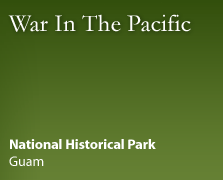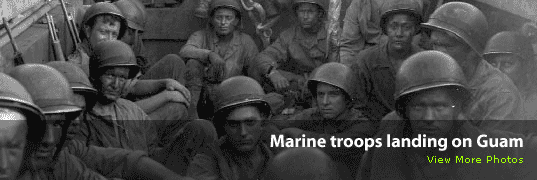| |
On December 8, 2002, Super-typhoon Pongsona passed over the US territory of Guam leaving its landscape torn and twisted. Located about 3,300 miles southwest of Hawaii in the Mariana Islands , Guam was the scene of intense fighting between Japanese and American Forces during the last World War. For this reason War in the Pacific National Historical Park was established in 1978 to commemorate the bravery and sacrifice of those participating in the Pacific Theater, conserving the historic and scenic values on the island of Guam. Unfortunately, one of the victims of Super-typhoon Pongsona was War in the Pacific National Historical Park.
The park is comprised of seven units encompassing almost 2,000 acres, that includes coral reefs, historical war-era encampments, bunkers, beaches, armaments, and the island’s only federally developed museum facility—the T. Stell Newman Museum. Few of these units escaped damage, and some facilities were completely destroyed during the twelve hours when the typhoon’s 160 mph winds (gusting to 184 mph) scoured the island. The Super-typhoon approached Guam just before noon on Sunday, December 8 th, and remained over the island until almost midnight. The eye of the storm passed in between the islands of Guam and Rota (both of the Mariana island chain) meaning that neither island had any reprieve from Pongsona’s destructive winds, rain, and surf.
The following day, people from all over the island awoke to view incredible damage across the island--which is only 30 miles long and 8 miles wide. Guam remained in Typhoon Condition until approximately two o’clock the following afternoon. Once the Governor declared the island was out of danger, park staff began assessing impacts and calculating damage. Assessment was hampered by island-wide loss of all communications due to fallen and damaged towers, and destroyed electrical infrastructure. When Biological Technician Ian Lundgren tried to reach Headquarters, he had to avoid collapsed buildings and dozens of concrete and steel utility poles that snapped like pencils all across the island. Shipping containers, cars, trucks, sports utility vehicles, and even jet skis littered the ocean buttressing Marine Drive. With no functioning traffic lights and obstacles impeding travel on the sand-covered road, park staff traveled for almost an hour to complete a drive that is less than five miles long. Upon arriving at the park’s museum and administrative offices, Dwayne Minton (Ecologist), Ian Lundrgren, and Jesse Palican (Arizona Memorial Museum Association), saw first-hand the immense power of the Super-typhoon.
Located directly along Asan Beach on the west-side of the island, park headquarters includes administration offices and the park museum that contains over 5,000 World War II artifacts, archives, and oral histories, not including the park’s resource library which contains over 850 books, 200 videos, and hundreds of topographical, nautical, administrative, architectural, and historic resource maps. As a result of Headquarters’ seaside location, overlooking a historical WW II assault landing beach, the ground-floor parking garage was submerged in sand, rock, coral, vegetation, and modern flotsam from Pongsona’s eight to 10 foot tidal surge. Above the garage, the first-floor theatre, bookstore, and museum exhibits were flooded as sea water driven by gale-force wind forced its way past storm shutters and locked doors, entering the building through window seals, door jams, ventilation ducts, and electrical outlets. In addition to severe flooding, flying debris, and accumulating deposition, the tidal surge collapsed walls for the building’s main electrical distribution panels, driving saltwater through electrical conduits and high voltage cable like milk through a straw.
As a result, in the days and weeks following Pongsona the park’s emergency generator could not be connected; and without island power, the entire building turned into a steamy, hot, moldy, jungle. To further complicate the weeks following the super-typhoon, the recovery was severely curtailed due to an uncontrolled petroleum tank-farm fire at Guam’s main harbor, apparently caused by static electricity from the storm. The fire closed the port for an additional week, debilitating the island for lack of fuel, food, and all cargo. With no island power, no island infrastructure, no communications, and no fuel, park headquarters like the rest of Guam sat helpless in 100 percent humidity. Within the course of only one week, the hot temperatures and high humidity which characterize Guam’s tropical climate caused mold to grow on walls and ceilings and created a musty, smelly, and unhealthy environment. Rotting plants and marine-life mixed with standing saltwater began to congeal in the museum and garage, permeating the building’s walls and carpeting. Many of the exhibits’ photos and captions began to peel and curl and black and white photographs started to re-develop, which produced orange and florescent pink and green colors on the formerly black and white images. With no power and the inability to connect the emergency generator because of damage to the building’s electrical components, it was determined that humidity, water, mold, and the lack of security was rapidly jeopardizing the museum and its holdings. With each passing day it was becoming obvious that typical island relief mechanisms would be delayed by the Holidays, the harbor fire, and the sheer magnitude of the super-typhoon. Park superintendent Eric Brunnemann consulted with park staff and island emergency services, and made the decision: Working with GSA, Federal Security, the US Attorney’s offices, US Fish and Wildlife, and most of all with a determined park staff, the order was given to abandon Headquarters. Three rooms were donated by GSA at the US Attorney’s offices in downtown Guam. These offices would soon become the first temporary repository for thousands of artifacts, archives, the park’s library, exhibits, oral history media, and controlled property.
Brunnemann, who started his NPS career as a museum technician, archeologist, and cultural resource manager, shouldedred the task of moving the entire collection upon acting curator Tammy Duchesne, who contacted Harper’s Ferry to implement the immediate evacuation of the museum. Calling from Guam to make contact with Harper’s Ferry, West Virginia, Tammy connected with museum specialist Alice Newton. With knowledge and kindness, Alice proceeded to ask questions about the types of items in the park’s collections. Alice carefully interviewed Tammy to find out the environmental and spatial conditions of the exhibits, archives, and museum collection storage area, focusing on the quantity and depth of the collections, types of cabinets and shelving, and what if any resources remained available for packing and moving the collections. The dynamics of an emergency evacuation was overwhelming enough, but it was complicated by the need to find dry packing materials that had not already been storm or humidity damaged. Articulate, descriptive, sympathetic, understanding, and reassuring, Alice described in great detail the actions and procedures that “ideally” should be executed to best preserve and protect the collection during its move. More importantly Alice also described the much more realistic “triage” approach to moving the collection when nothing ideal existed anymore.
In addition to providing curatorial expertise, Alice Newton also was aware of and sympathetic to Guam’s isolated location and locally non-existent access to museum, archival, and preservation supplies. Recognizing the fragility of the park’s heat and humidity sensitive collection (especially vulnerable in Guam’s tropical atmosphere), and taking into consideration the island’s crippled communication, Alice was able to procure and fly out essential supplies such as shrink-wrap, foam, tape, scissors, bags, markers, and other necessary materials that were impossible to obtain on Guam. Her immediate action on this task was integral to the collection’s survival as any normal requests made to the mainland would be inevitably delayed by the Holidays and recovery efforts at Guam’s burned-out port.
While waiting for supply packages to be air-shipped to Guam, Tammy began identifying those artifacts deemed particularly vulnerable to humidity and mold, and filling in the details of the evacuation plan with Superintendent Brunnemann. Utilizing park staff, Agency Human Resource Development personnel supplied by FEMA disaster relief funding (AHRD), NPS personnel from Haleakala National Park, and emergency NPS hires under an emergency administrative hiring authority (AD Hire), the evacuation of the museum and museum collections was administrated much like a wildfire operation. In 13 days, 14 cabinets were moved and six fully developed exhibits including clothing, weaponry, cartridges, insignia, and military equipment were disassembled, wrapped, boxed, and transported to the offices of the US Attorney. However the evacuation was not without unforeseen problems. Due to the port fire, island fuel had been exhausted and when available, it was either limited to emergency vehicles or rationed. The park’s fuel storage-tanks were immediately depleted, and fuel deliveries to the park had been cancelled by suppliers. Rental vehicles to support the move were not available because of island-wide damage to personal and public transportation. And with the arrival of FEMA and other emergency aid agencies, not a single rental vehicle could be acquired to support the move. In this worsening situation, post-typhoon rains and escalating humidity compelled staff to augment its fleet of NPS vehicles with vehicles supplied by its cooperating association personnel, private vehicles, and one large SUV from US Fish and Wildlife.
Despite these circumstances, over 5,000 items and shelving, cabinets, and associated administrative materials, were moved. Such items included original photographs, uniforms, rifles, bayonets, swords, currency, helmets, flags, posters, maps, paintings, machine guns, cartridges, medals, insignia, patches, newspapers, scrapbooks, programs, records, personal items, and letters. Through good advice, diligent work, and tireless effort, the diverse and historically significant collection was transported from an environment of mold, humidity, escalating temperatures, and no security, to the clean, climate controlled and secured offices donated by GSA.
Super-typhoon Pongsona confiscated electricity, water, fuel, climate control, communications, computers, internet service, and the park’s headquarters. It very nearly took the museum. While the Super-typhoon has temporarily or perhaps permanently claimed the park headquarters with its administrative offices, museum, bookstore, and museum storage, Pongsona was not allowed to claim the park’s collections or the spirit of its staff. Thanks to the diligent and tireless effort of over two dozen people, the park collections are once again in climate controlled and secure storage, awaiting their next move. While the fate of the park’s headquarters remains in question, the collection and library are currently safe and secure. Once a permanent site is made available, the WAPA staff will be forced to move the entire collection and library into its new home.
Thanks
This gargantuan move under the pressure of time and the elements could never have been executed without the assistance, cooperation, positive attitudes, motivation, and hard work of the permanent and emergency hire staff of the War in the Pacific National Historical Park including: Eric Brunnemann (Superintendent), Mary Mesa (admin officer), Dwayne Minton (Ecologist), Jim Powell (maintenance), Rita Powell (maintenance), Ali Spittler (park ranger), Elizabeth Cruz (park ranger), Ian Lundgren (biological technician); NPS Administrative Emergency Hires: Tammy Duchesne, Jireena Blas, Fred Cruz, Phil Scott-Smith, Paul Cruz, Frank Ungacta, Jr., Roque Mediola. Agency Human Resource Development personnel: Linda Aguon, Patrick Arceo, Silvestre Guillermo, Christopher Gumataotao, Debrorah Leon-Guerrero, Abraham Longa, Roy Taijeron, William Wusstig; Harper’s Ferry andAlice Newton(Museum specialist); Haleakala National Park; Bill Vines (electrician), Jennifer Talken-Spaulding (Park Ranger- Interpretation); Roger Bonnet (Building Manager Sirena Plaza), Gerald A. Melanson “Joe” (Senior Property Manager), Richard Riccio (GSA- Federal Police), Ed Talato (Deputy Administrative Office-Guam and CNMI), Mark Defley (Assistant Manager of Fish and Wildlife), the park’s Cooperating Association, the Arizona Museum Memorial Association, GSA, US Attorney’s Office, US Fish and Wildlife.
|
|





